The Project Gutenberg eBook of Birds, Illustrated by Color Photography, Vol. 2, No. 1
most other parts of the world at no cost and with almost no restrictions
whatsoever. You may copy it, give it away or re-use it under the terms
of the Project Gutenberg License included with this ebook or online
at www.gutenberg.org. If you are not located in the United States,
you will have to check the laws of the country where you are located
before using this eBook.
Title: Birds, Illustrated by Color Photography, Vol. 2, No. 1
Author: Various
Release date: November 21, 2009 [eBook #30523]
Most recently updated: January 5, 2021
Language: English
Credits: Produced by Chris Curnow, Joseph Cooper, Anne Storer, some
images courtesy of The Internet Archive and the Online
Distributed Proofreading Team at https://www.pgdp.net
*** START OF THE PROJECT GUTENBERG EBOOK BIRDS, ILLUSTRATED BY COLOR PHOTOGRAPHY, VOL. 2, NO. 1 ***
BIRDS
A MONTHLY SERIAL
ILLUSTRATED BY COLOR PHOTOGRAPHY
DESIGNED TO PROMOTE
KNOWLEDGE OF BIRD-LIFE
VOLUME II.
CHICAGO
Nature Study Publishing Company
copyright, 1897
by
Nature Study Publishing Co.
chicago.
INTRODUCTION.
This is the second volume of a series intended to present, in accurate
colored portraiture, and in popular and juvenile biographical text, a
very considerable portion of the common birds of North America, and
many of the more interesting and attractive specimens of other countries,
in many respects superior to all other publications which have attempted
the representation of birds, and at infinitely less expense. The
appreciative reception by the public of Vol. I deserves our grateful
acknowledgement. Appearing in monthly parts, it has been read and admired
by thousands of people, who, through the life-like pictures presented,
have made the acquaintance of many birds, and have since become
enthusiastic observers of them. It has been introduced into the public
schools, and is now in use as a text book by hundreds of teachers, who
have expressed enthusiastic approval of the work and of its general
extension. The faithfulness to nature of the pictures, in color and
pose, have been commended by such ornithologists and authors as Dr. Elliott
Coues, Mr. John Burroughs, Mr. J. W. Allen, editor of The Auk,
Mr. Frank M. Chapman, Mr. J. W. Baskett, and others.
The general text of Birds—the biographies—has been
conscientiously prepared from the best authorities by a careful observer
of the feather-growing denizens of the field, the forest, and the shore,
while the juvenile autobiographies have received the approval of the
highest ornithological authority.
The publishers take pleasure in the announcement that the general
excellence of Birds will be maintained in subsequent volumes.
The subjects selected for the third and fourth volumes—many of them—will
be of the rare beauty in which the great Audubon, the limner
par excellence of birds, would have found “the joy of imitation.”
Nature Study Publishing Company.
[Pg 1]
BIRDS.
Illustrated by COLOR PHOTOGRAPHY.
BIRD SONG.
T SHOULD not be overlooked
by the young observer that if
he would learn to recognize at
once any particular bird, he
should make himself acquainted
with the song and call notes of every
bird around him. The identification,
however, of the many feathered creatures
with which we meet in our rambles
has heretofore required so much
patience, that, though a delight to the
enthusiast, few have time to acquire
any great intimacy with them. To
get this acquaintance with the birds,
the observer has need to be prepared
to explore perilous places, to climb
lofty trees, and to meet with frequent
mishaps. To be sure if every veritable
secret of their habits is to be pried into,
this pursuit will continue to be plied
as patiently as it has ever been. The
opportunity, however, to secure a satisfactory
knowledge of bird song and
bird life by a most delightful method
has at last come to every one.
A gentleman who has taken a great
interest in Birds from the appearance
of the first number, but whose acquaintance
with living birds is quite limited,
visited one of our parks a few days
ago, taking with him the latest number
of the magazine. His object, he
said, was to find there as many
of the living forms of the specimens
represented as he could. “Seating
myself amidst a small grove
of trees, what was my delight at seeing
a Red Wing alight on a telegraph
wire stretching across the park. Examining
the picture in Birds I was
somewhat disappointed to find that the
live specimen was not so brilliantly
marked as in the picture. Presently,
however, another Blackbird alighted
near, who seemed to be the veritable
presentment of the photograph. Then
it occured to me that I had seen the
Red Wing before, without knowing its
name. It kept repeating a rich, juicy
note, oncher-la-ree-e! its tail tetering at
quick intervals. A few days later I
observed a large number of Red Wings
near the Hyde Park water works, in
the vicinity of which, among the trees
and in the marshes, I also saw many
other birds unknown to me. With
Birds in my hands, I identified the
Robin, who ran along the ground
quite close to me, anon summoning
with his beak the incautious angle
worm to the surface. The Jays were
noisy and numerous, and I observed
many new traits in the Wood Thrush,
so like the Robin that I was at first in
some doubt about it. I heard very
few birds sing that day, most of them
being busy in search of food for their
young.”
[continued on page 17.]
[Pg 2]
THE BALD-HEADED EAGLE.
Dear Boys and Girls:
I had hoped to show you
the picture of the eagle that
went through the war with the
soldiers. They called him “Old
Abe.” You will find on page 35
a long story written about
him. Ask some one to read it
to you.
I could not get “Old Abe,” or
you should now be looking at
his picture. He is at present in
Wisconsin, and his owner would
not allow him to be taken from
home.
I did the next best thing, and
found one that was very much
like him. They are as near
alike as two children of a
family. Old Abe’s feathers are
not quite so smooth, though. Do
you wonder, after having been
through the war? He is a
veteran, isn’t he?
The picture is that of a Bald-headed
Eagle. He is known,
also, by other names, such as
White-headed Eagle, Bird of
Washington, Sea Eagle.
You can easily see by the
picture that he is not bald-headed.
The name White-headed
would seem a better
name. It is because at a distance
his head and neck appear
as though they were covered
with a white skin.
He is called “Sea Eagle”
because his food is mostly fish.
He takes the fish that are thrown
upon the shores by the waves,
and sometimes he robs the Fish
Hawk of his food.
This mighty bird usually
places his large nest in some
tall tree. He uses sticks three
to five feet long, large pieces of
sod, weeds, moss, and whatever
he can find.
The nest is sometimes five or
six feet through. Eagles use the
same nest for years, adding to
it each year.
Young eagles are queer looking
birds. When hatched, they
are covered with a soft down
that looks like cotton.
Their parents feed them, and
do not allow them to leave the
nest until they are old enough
to fly. When they are old
enough, the mother bird pushes
them out of the nest. She must
be sure that they can fly, or she
would not dare do this. Don’t
you think so?
[Pg 3]
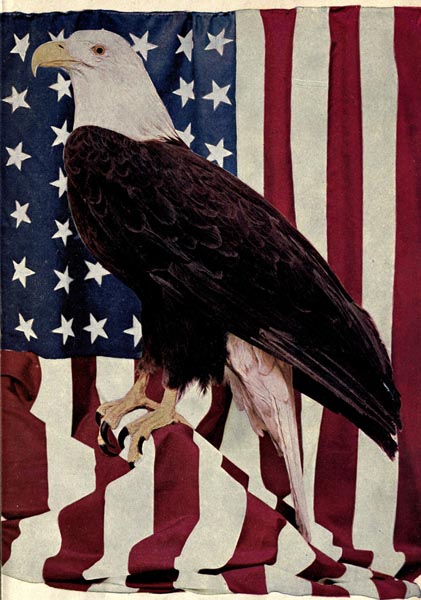
american bald eagle.
From col. Chi. Acad. Sciences.
[Pg 5]
THE BALD-HEADED EAGLE.

HIS mighty bird of lofty flight
is a native of the whole of
North America, and may be
seen haunting the greater
portions of the sea coasts, as well
as the mouths of large rivers. He is
sometimes called the White-headed
Eagle, the American Sea Eagle, the
Bird of Washington, the Washington
Eagle, and the Sea Eagle. On account
of the snowy white of his head and neck,
the name Bald Eagle has been applied
to him more generally than any other.
Sea-faring men are partial to young
Eagles as pets, there being a well
established superstition among them
that the ship that carries the
“King of Birds” can never go down. The
old Romans, in selecting the Eagle as
an emblem for their imperial standard,
showed this superstitious belief, regarding
him as the favorite messenger of
Jupiter, holding communion with
heaven. The Orientals, too, believed
that the feathers of the Eagle’s tail
rendered their arrows invincible. The
Indian mountain tribes east of Tennessee
venerated the Eagle as their
bird of war, and placed a high value
on his feathers, which they used for
headdresses and to decorate their pipes
of peace.
The United States seems to have an
abiding faith in the great bird, as our
minted dollars show.
The nest of the Bald Eagle is usually
placed upon the top of a giant tree,
standing far up on the side of a mountain,
among myriads of twining vines,
or on the summit of a high inaccessible
rock. The nest in the course of
years, becomes of great size as the
Eagle lays her eggs year after year in
the same nest, and at each nesting
season adds new material to the old
nest. It is strongly and comfortably
built with large sticks and branches,
nearly flat, and bound together with
twining vines. The spacious interior
is lined with hair and moss, so minutely
woven together as to exclude the wind.
The female lays two eggs of a brownish
red color, with many dots and
spots, the long end of the egg tapering
to a point. The parents are affectionate,
attend to their young as long as
they are helpless and unfledged, and
will not forsake them even though the
tree on which they rest be enveloped
in flames. When the Eaglets are
ready to fly, however, the parents push
them from the perch and trust them to
the high atmospheric currents. They
turn them out, so to speak, to shift for
themselves.
The Bald Eagle has an accommodating
appetite, eating almost anything
that has ever had life. He is fond of
fish, without being a great fisher, preferring
to rob the Fish-hawk of the
fruits of his skillful labor. Sitting
upon the side of a mountain his keen
vision surveys the plain or valley, and
detects a sheep, a young goat, a fat
turkey or rooster, a pig, a rabbit or a
large bird, and almost within an eye-twinkle
he descends upon his victim.
A mighty grasp, a twist of his talons,
and the quarry is dead long before the
Eagle lays it down for a repast. The
impetuosity and skill with which he
pursues, overtakes and robs the Fish-hawk,
and the swiftness with which
the Bald Eagle darts down upon and
seizes the booty, which the Hawk has
been compelled to let go, is not the
least wonderful part of this striking
performance.
The longevity of the Eagle is very
great, from 80 to 160 years.
[Pg 6]
THE SEMI-PALMATED RING PLOVER.
N THEIR habits the Plovers are
usually active; they run and
fly with equal facility, and
though they rarely attempt to
swim, are not altogether unsuccessful
in that particular.
The Semi-palmated Ring Plover
utters a plaintive whistle, and during
the nesting season can produce a few
connected pleasing notes. The three
or four pear-shaped, variagated eggs
are deposited in a slight hollow in the
ground, in which a few blades of grass
are occasionally placed. Both parents
assist in rearing the young. Worms,
small quadrupeds, and insects constitute
their food. Their flesh is regarded
as a delicacy, and they are therefore objects
of great attraction to the sportsman,
although they often render themselves
extremely troublesome by uttering
their shrill cry and thus warning their
feathered companions of the approach
of danger. From this habit they have
received the name of “tell-tales.” Dr.
Livingstone said of the African species:
“A most plaguey sort of public spirited
individual follows you everywhere,
flying overhead, and is most persevering
in his attempts to give fair warning
to all animals within hearing to
flee from the approach of danger.”
The American Ring Plover nests as
far north as Labrador, and is common
on our shores from August to October,
after which it migrates southward.
Some are stationary in the southern
states. It is often called the Ring Plover,
and has been supposed to be
identical with the European Ringed
Plover.
It is one of the commonest of shore
birds. It is found along the beaches
and easily identified by the complete
neck ring, white upon dark and dark
upon light. Like the Sandpipers the
Plovers dance along the shore in
rhythm with the wavelets, leaving
sharp half-webbed footprints on the
wet sand. Though usually found along
the seashore, Samuels says that on
their arrival in spring, small flocks
follow the courses of large rivers, like
the Connecticut. He also found a
single pair building on Muskeget, the
famous haunt of Gulls, off the shore of
Massachusetts. It has been found near
Chicago, Illinois, in July.
[Pg 8]
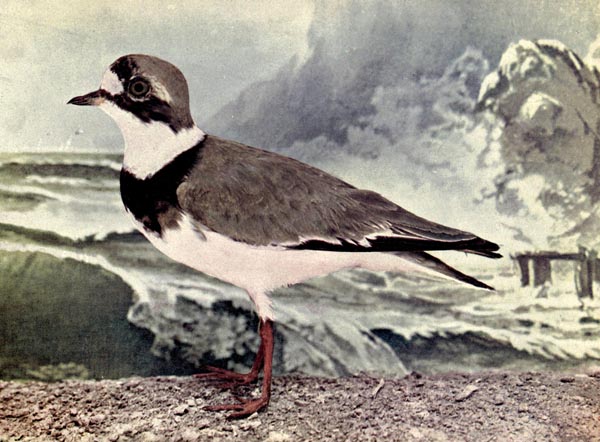
ring plover.
[Pg 9]
THE RING PLOVER.
Plovers belong to a class of
birds called Waders.
They spend the winters
down south, and early in the
spring begin their journey north.
By the beginning of summer
they are in the cold north, where
they lay their eggs and hatch
their young. Here they remain
until about the month of August,
when they begin to journey
southward. It is on their way
back that we see most of them.
While on their way north, they
are in a hurry to reach their
nesting places, so only stop here
and there for food and rest.
Coming back with their families,
we often see them in
ploughed fields. Here they find
insects and seeds to eat.
The Ring Plover is so called
from the white ring around its
neck.
These birds are not particular
about their nests. They do not
build comfortable nests as most
birds do. They find a place that
is sheltered from the north
winds, and where the sun will
reach them. Here they make a
rude nest of the mosses lying
around.
The eggs are somewhat
pointed, and placed in the nest
with the points toward the center.
In this way the bird can
more easily cover the eggs.
We find, among most birds,
that after the nest is made, the
mother bird thinks it her duty
to hatch the young.
The father bird usually feeds
her while she sits on the eggs.
In some of the bird stories, you
have read how the father and
mother birds take turns in building
the nest, sitting on the nest,
and feeding the young.
Some father birds do all the
work in building the nest,
and take care of the birds when
hatched.
Among plovers, the father
bird usually hatches the young,
and lets the wife do as she
pleases.
After the young are hatched
they help each other take care of
them.
Plovers have long wings, and
can fly very swiftly.
The distance between their
summer and winter homes is
sometimes very great.
[Pg 10]
THE MALLARD DUCK.
We should probably think this
the most beautiful of ducks, were
the Wood Duck not around.
His rich glossy-green head
and neck, snowy white collar,
and curly feathers of the tail
are surely marks of beauty.
But Mr. Mallard is not so
richly dressed all of the year.
Like a great many other birds,
he changes his clothes after the
holiday season is over. When
he does this, you can hardly tell
him from his mate who wears a
sober dress all the year.
Most birds that change their
plumage wear their bright,
beautiful dress during the summer.
Not so with Mr. Mallard.
He wears his holiday clothes
during the winter. In the summer
he looks much like his mate.
Usually the Mallard family
have six to ten eggs in their nest.
They are of a pale greenish
color—very much like the eggs
of our tame ducks that we see
about the barnyards.
Those who have studied birds
say that our tame ducks are
descendants of the Mallards.
If you were to hear the Mallard’s
quack, you could not tell it
from that of the domestic duck.
The Mallard usually makes
her nest of grass, and lines it
with down from her breast.
You will almost always find
it on the ground, near the water,
and well sheltered by weeds and
tall grasses.
It isn’t often you see a duck
with so small a family. It must
be that some of the ducklings
are away picking up food.
Do you think they look like
young chickens?
[Pg 11]
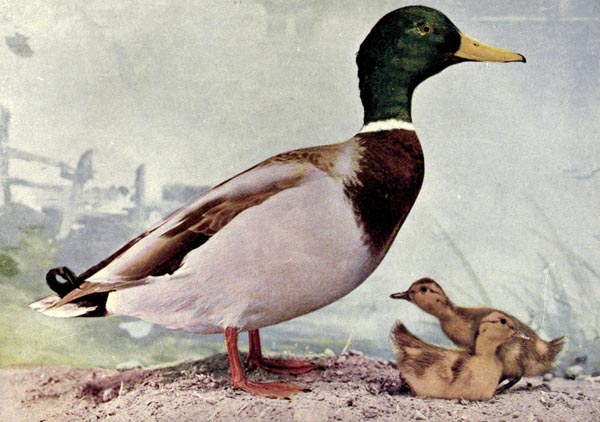
mallard duck.
From col. Chi. Acad. Sciences.
[Pg 13]
THE MALLARD DUCK.

HE Mallard Duck is generally
distributed in North America,
migrating south in winter to
Panama, Cuba, and the Bahamas.
In summer the full grown
male resembles the female, being
merely somewhat darker in color. The
plumage is donned by degrees in early
June, and in August the full rich
winter dress is again resumed. The
adult males in winter plumage vary
chiefly in the extent and richness of
the chestnut of the breast.
The Mallard is probably the best
known of all our wild ducks, being
very plentiful and remarkable on
account of its size. Chiefly migrant,
a few sometimes remain in the southern
portion of Illinois, and a few pairs
sometimes breed in the more secluded
localities where they are free from disturbance.
Its favorite resorts are margins
of ponds and streams, pools and
ditches. It is an easy walker, and can
run with a good deal of speed, or dive
if forced to do so, though it never
dives for food. It feeds on seeds of
grasses, fibrous roots of plants, worms,
shell fish, and insects. In feeding in
shallow water the bird keeps the hind
part of its body erect, while it searches
the muddy bottom with its bill.
When alarmed and made to fly, it
utters a loud quack, the cry of the
female being the louder. “It feeds
silently, but after hunger is satisfied,
it amuses itself with various jabberings,
swims about, moves its head backward
and forward, throws water over its
back, shoots along the surface, half
flying, half running, and seems quite
playful. If alarmed, the Mallard springs
up at once with a bound, rises obliquely
to a considerable height, and flies off
with great speed, the wings producing
a whistling sound. The flight is made
by repeated flaps, without sailing, and
when in full flight its speed is
hardly less than a hundred miles an
hour.”
Early in spring the male and female
seek a nesting place, building on the
ground, in marshes or among water
plants, sometimes on higher ground,
but never far from water. The nest
is large and rudely made of sedges and
coarse grasses, seldom lined with down
or feathers. In rare instances it nests
in trees, using the deserted nests of
hawks, crows, or other large birds.
Six or eight eggs of pale dull green
are hatched, and the young are covered
over with down. When the female
leaves the nest she conceals the eggs
with hay, down, or any convenient
material. As soon as hatched the
chicks follow the mother to the water,
where she attends them devotedly, aids
them in procuring food, and warns
them of danger. While they are attempting
to escape, she feigns lameness
to attract to herself the attention
of the enemy. The chicks are wonderfully
active little fellows, dive
quickly, and remain under water with
only the bill above the surface.
On a lovely morning, before the sun
has fairly indicated his returning presence,
there can be no finer sight than
the hurrying pinions, or inspiring
note than the squawk, oft repeated, of
these handsome feathered creatures, as
they seek their morning meal in the
lagoons and marshes.
[Pg 14]
THE AMERICAN AVOCET.

HITE SNIPE, Yelper,
Lawyer, and Scooper are
some of the popular
names applied in various
localities to this remarkably long-legged
and long and slender-necked
creature, which is to be found in temperate
North America, and, in winter,
as far south as Cuba and Jamaica. In
north-eastern Illinois the Avocet generally
occurs in small parties the last
of April and the first of May, and during
September and the early part of
October, when it frequents the borders
of marshy pools. The bird combines
the characteristics of the Curlew and
the Godwit, the bill being recurved.
The cinnamon color on the head
and neck of this bird varies with the
individual; sometimes it is dusky gray
around the eye, especially in the
younger birds.
The Avocet is interesting and attractive
in appearance, without having
any especially notable characteristics.
He comes and goes and is rarely seen
by others than sportsmen.
[Pg 15]
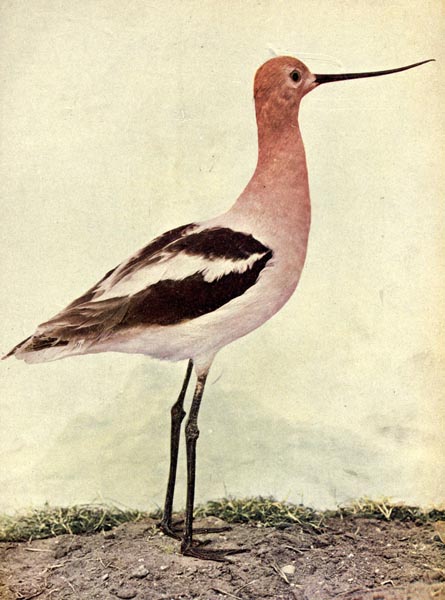
american avocet.
From col. F. M. Woodruff.
[Pg 17]
BIRD SONG—Continued from page 1.
Many of our singing birds may be
easily identified by any one who carries
in his mind the images which are presented
in our remarkable pictures.
See the birds at home, as it were, and
hear their songs.
Those who fancy that few native
birds live in our parks will be surprised
to read the following list of
them now visible to the eyes of so
careful an observer as Mr. J. Chester
Lyman.
“About the 20th of May I walked
one afternoon in Lincoln Park with a
friend whose early study had made
him familiar with birds generally, and
we noted the following varieties:
| 1 | Magnolia Warbler. | |
| 2 | Yellow Warbler. | |
| 3 | Black Poll Warbler. | |
| 4 | Black-Throated Blue Warbler. | |
| 5 | Black-Throated Queen Warbler. | |
| 6 | Blackburnian Warbler. | |
| 7 | Chestnut-sided Warbler. | |
| 8 | Golden-crowned Thrush. | |
| 9 | Wilson’s Thrush. | |
| 10 | Song Thrush. | |
| 11 | Catbird. | |
| 12 | Bluebird. | |
| 13 | Kingbird. | |
| 14 | Least Fly Catcher. | |
| 15 | Wood Pewee Fly Catcher. | |
| 16 | Great Crested Fly Catcher. | |
| 17 | Red-eyed Vireo. | |
| 18 | Chimney Swallow. | |
| 19 | Barn Swallow. | |
| 20 | Purple Martin. | |
| 21 | Red Start. | |
| 22 | House Wren. | |
| 23 | Purple Grackle. | |
| 24 | White-throated Sparrow. | |
| 25 | Song Sparrow. | |
| 26 | Robin. | |
| 27 | Blue Jay. | |
| 28 | Red-Headed Woodpecker. | |
| 29 | Kingfisher. | |
| 30 | Night Hawk. | |
| 31 | Yellow-Billed Cuckoo. | |
| 32 | Scarlet Tanager, Male and Female. | |
| 33 | Black and White Creeper. | |
| 34 | Gull, or Wilson’s Tern. | |
| 35 | The Omni-present English Sparrow. |
“On a similar walk, one week earlier,
we saw about the same number of
varieties, including, however, the Yellow
Breasted Chat, and the Mourning,
Bay Breasted, and Blue Yellow Backed
Warblers.”
The sweetest songsters are easily
accessible, and all may enjoy their
presence.
C. C. Marble.
[to be continued.]
[Pg 18]
THE CANVAS-BACK DUCK.

HITE-BACK, Canard Cheval,
(New Orleans,) Bull-Neck,
and Red-Headed
Bull-Neck, are common
names of the famous Canvas-Back,
which nests from the northern states,
northward to Alaska. Its range is
throughout nearly all of North America,
wintering from the Chesapeake
southward to Guatemala.
“The biography of this duck,” says
Mabel Osgood Wright, “belongs rather
to the cook-book than to a bird list,”
even its most learned biographers
referring mainly to its “eatable qualities,”
Dr. Coues even taking away its
character in that respect when he says
“there is little reason for squealing in
barbaric joy over this over-rated and
generally under-done bird; not one
person in ten thousand can tell it from
any other duck on the table, and only
then under the celery circumstances,”
referring to the particular flavor of its
flesh, when at certain seasons it feeds
on vallisneria, or “water celery,”
which won its fame. This is really
not celery at all, but an eel-grass, not
always found through the range of the
Canvas-Back. When this is scarce it
eats frogs, lizards, tadpoles, fish, etc.,
so that, says Mrs. Osgood, “a certificate
of residence should be sold with
every pair, to insure the inspiring
flavor.”
The opinion held as to the edible
qualities of this species varies greatly
in different parts of the country. No
where has it so high a reputation as in
the vicinity of Chesapeake Bay, where
the alleged superiority of its flesh is
ascribed to the abundance of “water
celery.” That this notion is erroneous
is evident from the fact that the same
plant grows in far more abundance in
the upper Mississippi Valley, where
also the Canvas-Back feeds on it.
Hence it is highly probable that fashion
and imagination, or perhaps a
superior style of cooking and serving,
play a very important part in the case.
In California, however, where the
“water celery” does not grow, the
Canvas-Back is considered a very inferior
bird for the table.
It has been hunted on Chesapeake
Bay and its tributaries with such inconsiderate
greed that its numbers have
been greatly reduced, and many have
been driven to more southern waters.
In and about Baltimore, the Canvas-Back,
like the famous terrapin, is in
as high favor for his culinary excellence,
as are the women for beauty and
hospitality. To gratify the healthy
appetite of the human animal this bird
was doubtless sent by a kind Providence,
none the less mindful of the creature
comforts and necessities of mankind
than of the purely aesthetic senses.
[Pg 20]
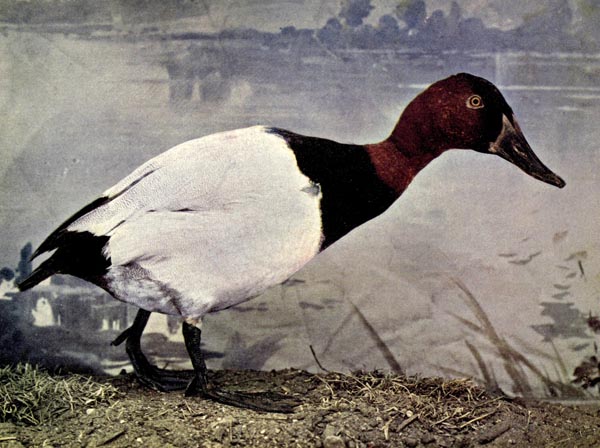
canvas-back duck.
From col. F. M. Woodruff.
[Pg 21]
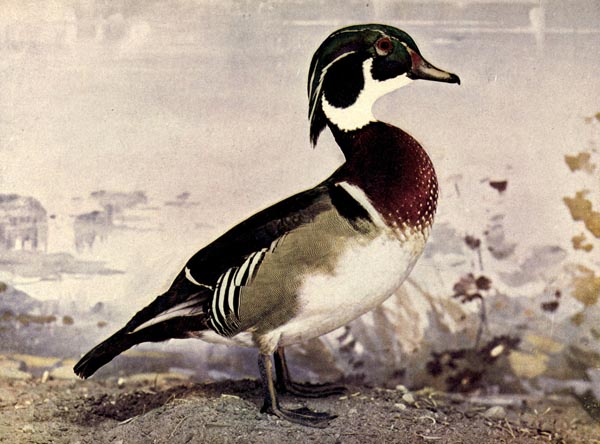
wood duck.
From col. F. M. Woodruff.
[Pg 23]
THE WOOD DUCK.
A great many people think
that this is the most beautiful
bird of North America. It is
called Wood Duck because it
usually makes its nest in the
hollow of a tree that overhangs
the water. If it can find a
squirrel’s or woodpecker’s hole
in some stump or tree, there it
is sure to nest.
A gentleman who delighted in
watching the Wood Duck, tells
about one that built her nest in
the hollow of a tree that hung
over the water. He was anxious
to see how the little ones, when
hatched, would get down.
In a few days he knew that
the ducklings were out, for he
could hear their pee, pee, pee.
They came to the edge of the
nest, one by one, and tumbled
out into the water.
You know a duck can swim
as soon as it comes out of the
egg.
Sometimes the nest is in the
hollow of a tree that is a short
distance from the water.
Now how do you suppose the
ducklings get there as they do?
If the nest is not far from the
ground, the mother bird lets
them drop from it on the
dried grass and leaves under
the tree. She then carries them
in her bill, one by one, to the
water and back to the nest.
If the nest should be far from
the ground, she carries them
down one by one.
This same gentleman says
that he once saw a Wood Duck
carry down thirteen little ones
in less than ten minutes. She
took them in her bill by the
back of the neck or the wing.
When they are a few days old
she needs only to lead the way
and the little ones will follow.
The Wood Duck is also called
Summer Duck. This is because
it does not stay with us during
the winter, as most ducks do.
It goes south to spend the
winter and comes back north
early in the spring.
[Pg 24]
THE WOOD DUCK.

UITE the most beautiful of
the native Ducks, with a
a richness of plumage which
gives it a bridal or
festive appearance, this
bird is specifically named Spousa, which
means betrothed. It is also called
Summer Duck, Bridal Duck, Wood
Widgeon, Acorn Duck and Tree Duck.
It is a fresh water fowl, and exclusively
so in the selection of its nesting
haunts. It inhabits the whole of temperate
North America, north to the
fur countries, and is found in Cuba
and sometimes in Europe. Its favorite
haunts are wooded bottom-lands,
where it frequents the streams and
ponds, nesting in hollows of the largest
trees. Sometimes a hole in a horizontal
limb is chosen that seems too
small to hold the Duck’s plump body,
and occasionally it makes use of the
hole of an Owl or Woodpecker, the
entrance to which has been enlarged
by decay.
Wilson visited a tree containing a
nest of a Wood or Summer Duck, on
the banks of Tuckahoe river, New
Jersey. The tree stood on a declivity
twenty yards from the water, and in
its hollow and broken top, about six
feet down, on the soft decayed wood
were thirteen eggs covered with down
from the mother’s breast. The eggs
were of an exact oval shape, the surface
smooth and fine grained, of a yellowish
color resembling old polished
ivory. This tree had been occupied
by the same pair, during nesting time,
for four successive years. The female
had been seen to carry down from the
nest thirteen young, one by one, in
less than ten minutes. She caught
them in her bill by the wing or back
of the neck, landed them safely at the
foot of the tree, and finally led them
to the water. If the nest be directly
over the water, the little birds as soon
as hatched drop into the water, breaking
their fall by extending their wings.
Many stories are told of their attachment
to their nesting places. For
several years one observer saw a pair
of Wood Ducks make their nest in the
hollow of a hickory which stood on
the bank, half a dozen yards from a
river. In preparing to dam the river
near this point, in order to supply
water to a neighboring city, the course
of the river was diverted, leaving the
old bed an eighth of a mile behind,
notwithstanding which the ducks bred
in the old place, the female undaunted
by the distance which she would have
to travel to lead her brood to the water.
While the females are laying, and
afterwards when sitting, the male
usually perches on an adjoining limb
and keeps watch. The common note
of the drake is peet-peet, and when
standing sentinel, if apprehending
danger, he makes a noise not unlike
the crowing of a young cock, oe-eek.
The drake does not assist in sitting on
the eggs, and the female is left in the
lurch in the same manner as the Partridge.
The Wood Duck has been repeatedly
tamed and partially domesticated.
It feeds freely on corn meal soaked in
water, and as it grows, catches flies
with great dexterity.
[Pg 26]
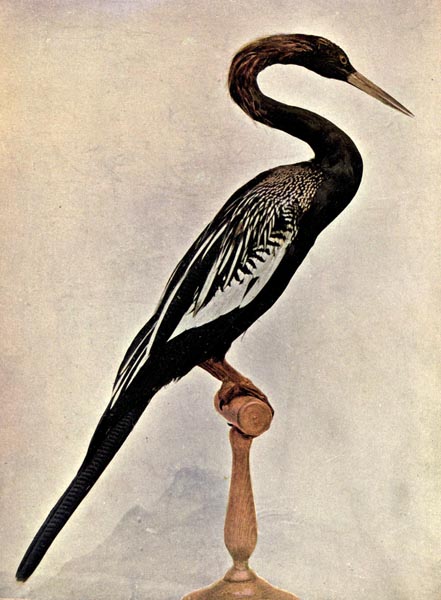
anhinga or snake bird.
From col. F. C. Baker.
[Pg 27]
THE ANHINGA OR SNAKE BIRD.

HE Snake Bird is very singular
indeed in appearance, and interesting
as well in its habits.
Tropical and sub-tropical
America, north to the Carolinas and
Southern Illinois, where it is a regular
summer resident, are its known haunts.
Here it is recognized by different
names, as Water Turkey, Darter, and
Snake Bird. The last mentioned
seems to be the most appropriate name
for it, as the shape of its head and neck
at once suggest the serpent. In Florida
it is called the Grecian Lady, at
the mouth of the Mississippi, Water
Crow, and in Louisiana, Bec a Lancette.
It often swims with the body
entirely under water, its head and long
neck in sight like some species of
water snakes, and has no doubt more
than once left the impression on the
mind of the superstitious sailor that
he has seen a veritable sea serpent, the
fear of which lead him to exaggerate
the size of it.
This bird so strange in looks and
action is common in summer in the
South Atlantic and Gulf States, frequenting
the almost impenetrable
swamps, and is a constant resident of
Florida.
As a diver the Snake Bird is the
most wonderful of all the Ducks. Like
the Loon it can disappear instantly
and noiselessly, swim a long distance
and reappear almost in an opposite
direction to that in which naturally it
would be supposed to go. And the
ease with which, when alarmed, it will
drop from its perch and leave scarcely
a ripple on the surface of the water,
would appear incredible in so large a
bird, were it not a well known fact.
It has also the curious habit of sinking
like a Grebe.
The nests of the Anhinga are located
in various places, sometimes in low
bushes at a height from the ground of
only a few feet, or in the upper
branches of high trees, but always over
water. Though web footed, it is
strong enough to grasp tightly the
perch on which it nests. This gives
it a great advantage over the common
Duck which can nest only on the
ground. Sometimes Snake Birds breed
in colonies with various species of
Herons. From three to five eggs,
bluish, or dark greenish white, are
usually found in the nest.
Prof. F. C. Baker, secretary of the
Chicago Academy of Sciences, to whom
we are indebted for the specimen presented
here, captured this bird at
Micco, Brevard Co., Florida, in April,
1889. He says he found a peculiar
parasite in the brain of the Anhinga.
The Anhingas consist of but one
species, which has a representative in
the warmer parts of each of the great
divisions of the earth. The number
seen together varies from eight or ten
to several hundred.
The hair-like feathers on the
neck form a sort of loose mane.
When asleep the bird stands with
its body almost erect. In rainy
weather it often spends the greater
part of the day in an erect attitude,
with its neck and head stretched upward,
remaining perfectly motionless,
so that the water may glide off its
plumage. The fluted tail is very thick
and beautiful and serves as a propeller
as well as a rudder in swimming.
[Pg 28]
THE AMERICAN WOODCOCK.
SN’T this American Woodcock,
or indeed any member of the
family, a comical bird? His
head is almost square, and
what a remarkable eye he has!
It is a seeing eye, too, for he does not
require light to enable him to detect
the food he seeks in the bogs. He
has many names to characterize
him, such as Bog-sucker, Mud Snipe,
Blind Snipe. His greatest enemies
are the pot hunters, who nevertheless
have nothing but praise to bestow
upon him, his flesh is so exquisitely
palatable. Even those who deplore
and deprecate the destruction of birds
are not unappreciative of his good
qualities in this respect.
The Woodcock inhabits eastern
North America, the north British
provinces, the Dakotas, Nebraska and
Kansas, and breeds throughout the
range.
Night is the time when the Woodcock
enjoys life. He never flies voluntarily
by day, but remains secluded
in close and sheltered thickets till twilight,
when he seeks his favorite feeding
places. His sight is imperfect
by day, but at night he readily
secures his food, assisted doubtless by
an extraordinary sense of smell. His
remarkably large and handsome eye is
too sensitive for the glare of the sun,
and during the greater part of the day
he remains closely concealed in marshy
thickets or in rank grass. In the
morning and evening twilight and on
moonlight nights, he seeks his food in
open places. The early riser may find
him with ease, but the first glow from
the rays of the morning sun will cause
his disappearance from the landscape.
He must be looked for in swamps,
and in meadows with soft bottoms.
During very wet seasons he seeks
higher land—usually cornfields—and
searches for food in the mellow
plowed ground, where his presence is
indicated by holes made by his bill.
In seasons of excessive drought the
Woodcock resorts in large numbers to
tide water creeks and the banks of
fresh water rivers. So averse is he to
an excess of water, that after continued
or very heavy rains he has been known
suddenly to disappear from widely
extended tracts of country.
A curious habit of the Woodcock,
and one that is comparatively little
known, is that of carrying its young
in order to remove them from danger.
So many trustworthy naturalists maintain
this to be true that it must be
accepted as characteristic of this interesting
bird. She takes her young from
place to place in her toe grasps as
scarcity of food or safety may require.
As in the case of many birds whose
colors adapt them to certain localities
or conditions of existence, the patterns
of the beautiful chestnut parts of the
Woodcock mimic well the dead leaves
and serve to protect the female and
her young. The whistle made by
their wings when flying is a manifestation
of one of the intelligences of
nature.
The male Woodcock, it is believed,
when he gets his “intended” off entirely
to himself, exhibits in peculiar
dances and jigs that he is hers and
hers only, or rises high on the wing
cutting the most peculiar capers and
gyrations in the air, protesting to her
in the grass beneath the most earnest
devotion, or advertising to her his
whereabouts.
[Pg 30]
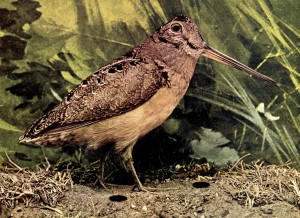
american woodcock.
From col. Chi. Acad. Sciences.
[Pg 31]
THE WOODCOCK.
Here is a bird that is not
often seen in the daytime.
During the day he stays in
the deep woods or among the
tall marsh grasses.
It is at twilight that you may
see him. He then comes out in
search of food.
Isn’t he an odd-looking bird?
His bill is made long so that he
can bore into the soft ground
for earthworms.
You notice his color is much
like the Ruffed Grouse in June
“BIRDS.” This seems to be the
color of a great many birds
whose home is among the
grasses and dried leaves. Maybe
you can see a reason for this.
Those who have watched the
Woodcock carefully, say that he
can move the tip end of the
upper part of his bill. This
acts like a finger in helping him
to draw his food from the
ground.
What a sight it must be to see
a number of these queer looking
birds at work getting their food.
If they happen to be in a swampy
place, they often find earthworms
by simply turning over
the dead leaves.
If there should be, near by, a
field that has been newly
plowed, they will gather in
numbers, at twilight, and search
for worms.
The Woodcock has short
wings for his size. He seems
to be able to fly very fast. You
can imagine how he looks while
flying—his long bill out in front
and his legs hanging down.
[Pg 32]
THE AMERICAN SCOTER.

HE specimen we give of the
American Scoter is one of
unusual rarity and beauty of
plumage. It was seen off the
government pier, in Chicago, in November,
1895, and has been much
admired.
The Scoter has as many names as
characteristics, being called the Sea
Coot, the Butter-billed, and the Hollow-billed
Coot. The plumage of the full
grown male is entirely black, while
the female is a sooty brown, becoming
paler below. She is also somewhat
smaller.
This Duck is sometimes found in
great numbers along the entire Atlantic
coast where it feeds on small shell
fish which it secures by diving. A
few nest in Labrador, and in winter it
is found in New Jersey, on the Great
Lakes, and in California. The neighborhoods
of marshes and ponds are its
haunts, and in the Hudson Bay region
the Scoter nests in June and July.
The nest is built on the ground near
water. Coarse grass, feathers, and
down are commonly used to make it
comfortable, while it is well secreted
in hollows in steep banks and cliffs.
The eggs are from six to ten, of a dull
buff color.
Prof. Cooke states that on May 2,
1883, fifty of these ducks were seen at
Anna, Union county, Illinois, all
busily engaged in picking up millet
seed that had just been sown. If no
mistake of identification was made in
this case, the observation apparently
reveals a new fact in the habits of the
species, which has been supposed to
feed exclusively in the water, and to
subsist generally on fishes and other
aquatic animal food.
[Pg 33]
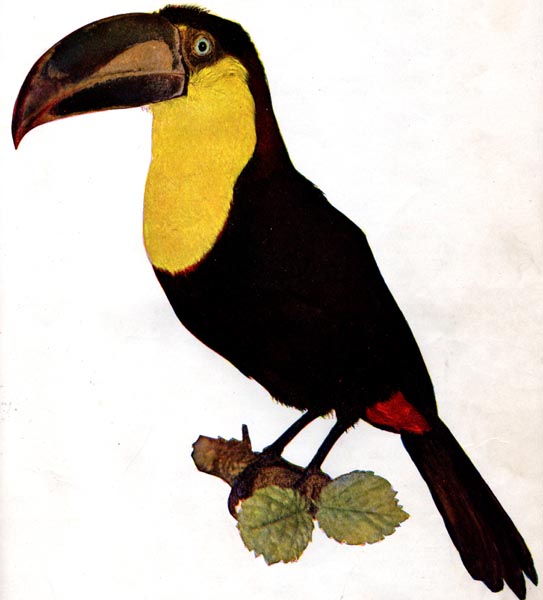
white-winged scoter.
From col. F. M. Woodruff.
[Pg 35]
OLD ABE.
“I’d rather capture Old Abe,” said Gen. Sterling Price, of the
Confederate Army, “than a whole brigade.”

LD ABE” was the live
war Eagle which accompanied
the Eighth Wisconsin
regiment during
the War of the Rebellion. Much of a
more or less problematical character
has been written about him, but what
we regard as authentic we shall present
in this article. Old Abe was a
fine specimen of the Bald Eagle, very
like the one figured in this number of
Birds. Various stories are told of his
capture, but the most trustworthy account
is that Chief Sky, a Chippewa
Indian, took him from the nest while
an Eaglet. The nest was found on a
pine tree in the Chippewa country, about
three miles from the mouth of the
Flambeau, near some rapids in the
river. He and another Indian cut the
tree down, and, amid the menaces of
the parent birds, secured two young
Eagles about the size of Prairie Hens.
One of them died. The other, which
lived to become historical, was sold to
Daniel McCann for a bushel of corn.
McCann carried it to Eau Claire, and
presented it to a company then being
organized as a part of the Eighth
Wisconsin Infantry.
What more appropriate emblem than
the American Bald-headed Bird could
have been thus selected by the patriots
who composed this regiment of freemen!
The Golden Eagle (of which
we shall hereafter present a splendid
specimen,) with extended wings, was
the ensign of the Persian monarchs,
long before it was adopted by the
Romans. And the Persians borrowed
the symbol from the Assyrians. In
fact, the symbolical use of the Eagle
is of very remote antiquity. It was
the insignia of Egypt, of the Etruscans,
was the sacred bird of the Hindoos,
and of the Greeks, who connected him
with Zeus, their supreme deity. With
the Scandinavians the Eagle is the
bird of wisdom. The double-headed
Eagle was in use among the Byzantine
emperors, “to indicate their claims to
the empire of both the east and the
west.” It was adopted in the 14th
century by the German emperors.
The arms of Prussia were distinguished
by the Black Eagle, and
those of Poland by the White. The
great Napoleon adopted it as the emblem
of Imperial France.
Old Abe was called by the soldiers
the “new recruit from Chippewa,”
and sworn into the service of the
United States by encircling his neck
with red, white, and blue ribbons, and
by placing on his breast a rosette of
colors, after which he was carried by
the regiment into every engagement
in which it participated, perched upon
a shield in the shape of a heart. A
few inches above the shield was a
grooved crosspiece for the Eagle to
rest upon, on either end of which were
three arrows. When in line Old Abe
was always carried on the left of the
color bearer, in the van of the regiment.
The color bearer wore a belt
to which was attached a socket for the
end of the staff, which was about five
feet in length. Thus the Eagle was
high above the bearer’s head, in plain
sight of the column. A ring of leather
was fastened to one of the Eagle’s legs
to which was connected a strong hemp
cord about twenty feet long.
Old Abe was the hero of about
twenty-five battles, and as many
skirmishes. Remarkable as it may
appear, not one bearer of the flag, or
of the Eagle, always shining marks for
the enemy’s rifles, was ever shot down.
[Pg 36]
Once or twice Old Abe suffered the
loss of a few feathers, but he was never
wounded.
The great bird enjoyed the excitement
of carnage. In battle he flapped
his wings, his eyes blazed, and with
piercing screams, which arose above
the noise of the conflict, seemed to
urge the company on to deeds of valor.
David McLane, who was the first
color bearer to carry him into battle,
said:
“Old Abe, like all old soldiers,
seemed to dread the sound of musketry
but with the roll of artillery he appeared
to be in his glory. Then he
screamed, spread his wings at every
discharge, and reveled in the roar and
smoke of the big guns.” A correspondent
who watched him closely said
that when a battle had fairly begun
Old Abe jumped up and down on his
perch with such wild and fearful
screams as an eagle alone can utter.
The louder the battle, the fiercer and
wilder were his screams.
Old Abe varied his voice in accord
with his emotions. When surprised
he whistled a wild melody of a melancholy
softness; when hovering over
his food he gave a spiteful chuckle;
when pleased to see an old friend he
seemed to say: “How do you do?”
with a plaintive cooing. In battle his
scream was wild and commanding, a
succession of five or six notes with a
startling trill that was inspiring to
the soldiers. Strangers could not approach
or touch him with safety,
though members of the regiment who
treated him with kindness were cordially
recognized by him. Old Abe
had his particular friends, as well as
some whom he regarded as his enemies.
There were men in the company whom
he would not permit to approach him.
He would fly at and tear them with
his beak and talons. But he would
never fight his bearer. He knew his
own regiment from every other, would
always accompany its cheer, and never
that of any other regiment.
Old Abe more than once escaped,
but was always lured by food to return.
He never seemed disposed to depart to
the blue empyrean, his ancestral home.
Having served three years, a portion
of the members of Company C were
mustered out, and Old Abe was presented
to the state of Wisconsin. For
many years, on occasions of public
exercise or review, like other illustrious
veterans, he excited in parade universal
and enthusiastic attention.
He occupied pleasant quarters in the
State Capitol at Madison, Wisconsin,
until his death at an advanced age.
[Pg 38]
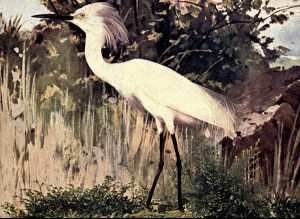
snowy heron or little egret.
From col. F. M. Woodruff.
CHICAGO COLORTYPE CO.
[Pg 39]
THE SNOWY HERON.
“What does it cost this garniture of death?
It costs the life which God alone can give;
It costs dull silence where was music’s breath,
It costs dead joy, that foolish pride may live.
Ah, life, and joy, and song, depend upon it,
Are costly trimmings for a woman’s bonnet!”
—May Riley Smith.

EMPERATE and tropical America,
from Long Island to
Oregon, south to Buenos Ayres,
may be considered the
home of the Snowy Heron, though it
is sometimes seen on the Atlantic
coast as far as Nova Scotia. It is supposed
to be an occasional summer resident
as far north as Long Island, and
it is found along the entire gulf coast
and the shores of both oceans. It is
called the Little White Egret, and is
no doubt the handsomest bird of the
tribe. It is pure white, with a crest
composed of many long hair-like
feathers, a like plume on the lower
neck, and the same on the back, which
are recurved when perfect.
Snowy Herons nest in colonies, preferring
willow bushes in the marshes
for this purpose. The nest is made in
the latter part of April or early June.
Along the gulf coast of Florida, they
nest on the Mangrove Islands, and in
the interior in the willow ponds and
swamps, in company with the Louisiana
and Little Blue Herons. The nest
is simply a platform of sticks, and from
two to five eggs are laid.
Alas, plume hunters have wrought
such destruction to these lovely birds
that very few are now found in the old
nesting places. About 1889, according
to Mr. F. M. Woodruff, this bird
was almost completely exterminated in
Florida, the plume hunters transferring
their base of operation to the
Texas coast of the Gulf, and the bird
is now in a fair way to be utterly
destroyed there also. He found them
very rare in 1891 at Matagorda Bay,
Texas. This particular specimen is a
remarkably fine one, from the fact that
it has fifty-two plumes, the ordinary
number being from thirty to forty.
Nothing for some time has been
more commonly seen than the delicate
airy plumes which stand upright in
ladies’ bonnets. These little feathers,
says a recent writer, were provided by
nature as the nuptial adornment of the
White Heron. Many kind-hearted
women who would not on any account
do a cruel act, are, by following this
fashion, causing the continuance of a
great cruelty. If ladies who are seemingly
so indifferent to the inhumanity
practiced by those who provide them
with this means of adornment would
apply to the Humane Education Committee,
Providence, R. I., for information
on the subject, they would themselves
be aroused to the necessity of
doing something towards the protection
of our birds. Much is, however,
being done by good men and women
to this end.
The Little Egret moves through the
air with a noble and rapid flight. It
is curious to see it pass directly
overhead. The head, body and legs
are held in line, stiff and immovable,
and the gently waving wings carry the
bird along with a rapidity that seems
the effect of magic.
An old name of this bird was Hern,
or Hernshaw, from which was derived
the saying, “He does not know a
Hawk from a Hernshaw.” The last
word has been corrupted into “handsaw,”
rendering the proverb meaningless.
[Pg 40]
SUMMARY
Page 3.
BALD EAGLE.—Haliæetus leucocephalus.
Other names: “White-headed Eagle,” “Bird of Washington,”
“Gray Eagle,” “Sea Eagle.”
Dark brown. Head, tail, and tail coverts white.
Tarsus, naked. Young with little or no white.
Range—North America, breeding throughout
its range.
Nest—Generally in tall trees.
Eggs—Two or three, dull white.
Page 8.
SEMI-PALMATED PLOVER.—Ægialitis
semi-palmata. Other names: “American Ring Plover,”
“Ring Neck,” “Beach Bird.” Front,
throat, ring around neck, and entire under
parts white; band of deep black across the
breast; upper parts ashy brown. Toes connected
at base.
Range—North America in general, breeding
in the Arctic and sub-arctic districts, winters
from the Gulf States to Brazil.
Nest—Depression in the ground, with lining
of dry grass.
Eggs—Three or four; buffy white, spotted
with chocolate.
Page 11.
MALLARD DUCK.—Anas boschas. Other
names: “Green-head,” “Wild Duck.” Adult
male, in fall, winter, and spring, beautifully
colored; summer, resembles female—sombre.
Range—Northern parts of Northern Hemisphere.
Nest—Of grasses, on the ground, usually
near the water.
Eggs—Six to ten; pale green or bluish white.
Page 15.
AMERICAN AVOCET.—Recurvirostra
americana. Other names: “White Snipe,”
“Yelper,” “Lawyer,” “Scooper.”
Range—Temperate North America.
Nest—A slight depression in the ground.
Eggs—Three or four; pale olive or buffy clay
color, spotted with chocolate.
Page 20.
CANVAS-BACK.—Aythya vallisneria.
Other names: “White-Back,” “Bull-Neck,”
“Red-Headed Bull-Neck.”
Range—North America. Breeds only in the
interior, from northwestern states to the Arctic
circle; south in winter to Guatemala.
Nest—On the ground, in marshy lakesides.
Eggs—Six to ten; buffy white, with bluish
tinge.
Page 21.
WOOD DUCK.—Aix sponsa. Coloring
varied; most beautiful of ducks. Other names:
“Summer Duck,” “Bridal Duck,” “Wood Widgeon,” “Tree Duck.”
Range—North America. Breeds from
Florida to Hudson’s Bay; winters south.
Nest—Made of grasses, usually placed in a
hole in tree or stump.
Eggs—Eight to fourteen; pale, buffy white.
Page 26.
SNAKE BIRD.—Anhinga anhinga. Other
names: “Water Turkey,” “Darter,” “Water Crow,” “Grecian Lady.”
Range—Tropical and sub-tropical America.
Nest—Of sticks, lined with moss, rootlets,
etc., in a bush or tree over the water.
Eggs—Two to four; bluish white, with a
chalky deposit.
Page 30.
AMERICAN WOODCOCK.—Philohela
minor. Other names: “Bog-sucker,” “Mud Snipe,” “Blind Snipe.”
Range—Eastern North America, breeding
throughout its range.
Nest—Of dried leaves, on the ground.
Eggs—Four; buffy, spotted with shades of
rufous.
Page 33.
WHITE-WINGED SCOTER.—Oidemia
deglandi. Other names: “American Velvet Scoter,”
“White-winged Coot,” “Uncle Sam Coot.”
Range—Northern North America; breeding
in Labrador and the fur countries; south in
winter.
Nest—On the ground, beneath bushes.
Eggs—Six to ten; pale, dull buff.
Page 38.
SNOWY HERON.—Ardea candidissima.
Other names: “Little Egret,” “White-crested Egret,” “White Poke.”
Range—Tropical and temperate America.
Nest—A platform of sticks, in bushes, over
water.
Eggs—Three to five; pale, dull blue.
Featured Books

Systematic Status of the Colubrid Snake, Leptodeira discolor Günther
William Edward Duellman
ollected inOaxaca, México, by Auguste Sallé. Information concerning thescutellation and coloration...

Birds, Illustrated by Color Photography, Vol. 2, No. 2
Various
the work and of itsgeneral extension. The faithfulness to nature of the pictures, in color andpose,...

Vertebrates from the Barrier Island of Tamaulipas, México
Richard F. Johnston, Robert K. Selander, B. J. Wilks, and Gerald G. Raun
xico and the Laguna Madre deTamaulipas is a narrow barrier island extending from the delta ofthe Rio...

The Venus Trap
Evelyn E. Smith
ns to rule out an otherwisesuitable planet. This particular group of settlers had been lucky,indeed,...

The Angel Children
Charlotte M. Higgins
re auniform value and appearance is desired, they are excellent.LEE & SHEPARD, Publishers, Bosto...

Erling the Bold
R. M. Ballantyne
ly necessary to self-preservation.Most of them wore portions of scale armour, or shirts of ring mail...

Rujub, the Juggler
G. A. Henty
reak occurred at Meerut, where were stationed about two thousand English soldiers and three tho...

A Matter of Importance
Murray Leinster
ght star,which was the sol-type sun Varenga. The torp sped toward it on a newschedule. Its overdrive...
Browse by Category
Join Our Literary Community
Subscribe to our newsletter for exclusive book recommendations, author interviews, and upcoming releases.
Comments on "Birds, Illustrated by Color Photography, Vol. 2, No. 1" :